



Attraction

Recreation
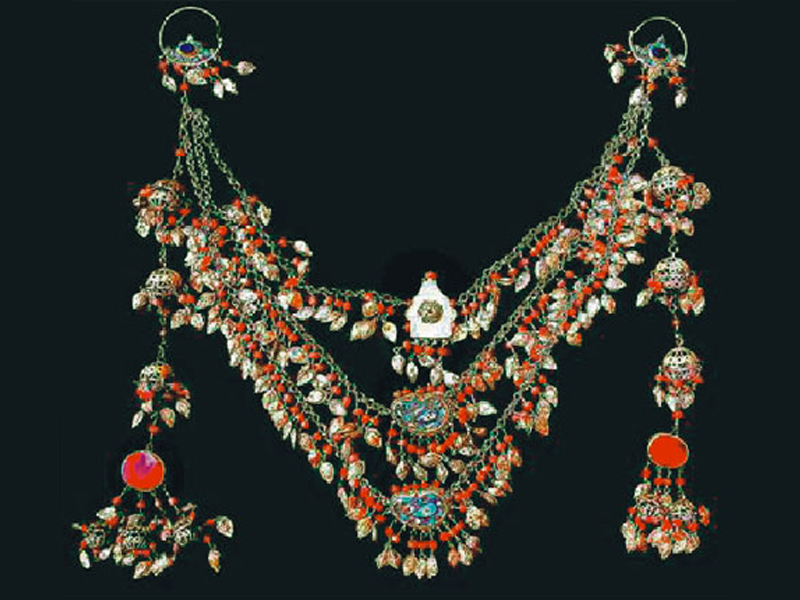
In 1830s-1840s the most developed craft if Khiva was jewellery-making, also known as “the mastery of gold and silver smithery”. In 1850s-1860s among Khiva’s quarter mosques were those named after craftsmen, such as Klychbai mosque, the “catchment” area of which was a quarter with nine households. The 1860 list of Khiva craftsmen included twelve jewellers.
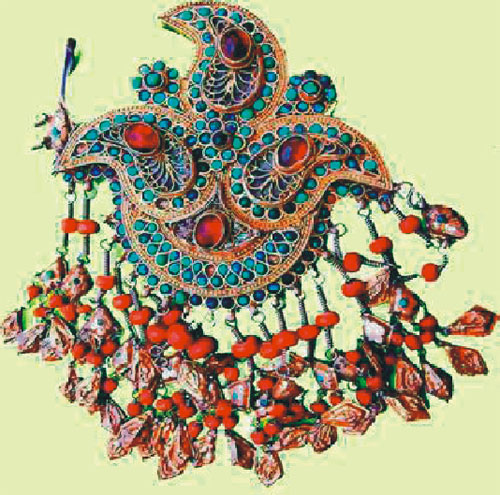
The decor of the 19th century jewellery was dominated by vegetable ornament; yet geometric and zoomorphic motifs were also used. Jewellery items can be conventionally divided into several groups: headpieces, forehead and temple pieces, forehead pieces, forehead-temple-neck pieces, temple pieces, pieces for hair plaits, nose, ears, neck, chest, shoulders, armpits, girdle and arms. These items were put together in sets worn at a certain age and in different situations. The concept of a “set” usually did not correspond with the concept of an “ensemble”. Some items were made to order, some were inherited.
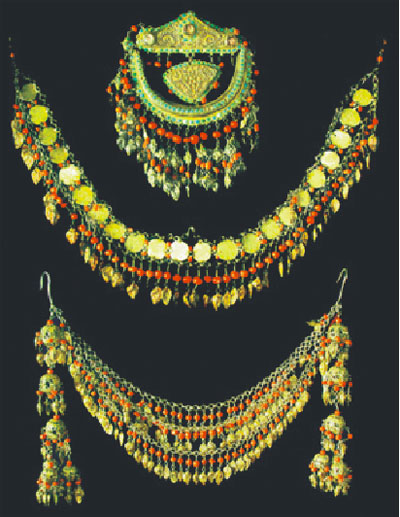
Most favoured jewellery item of Khorezmian women is shokila that consists of several elements: a diadem with lots of pendants decorated with enamel of many colours; temple pendants; two or three necklaces of different length worn under the chin, on the neck and chest. At the end of the 19th century these items get separated, and a separate temple-chest piece, just as a forehead-temple piece, is also called shokila.
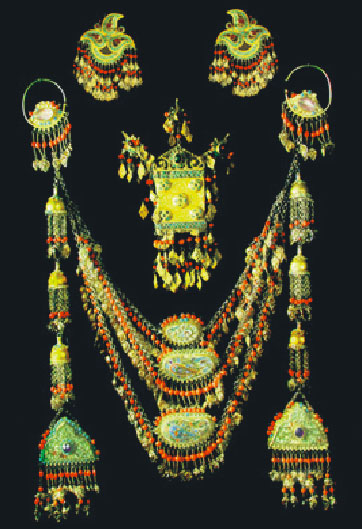
On Photograph 1, a girl sitting on the left hand side wears a temple-chest shokila, and both girls wear chest peshkhalta, the evidence of their belonging to the well-to-do class. Shokila is wrought in a more modest fashion, its chains consist of elements in the shape of numeral 8, attached to which are short pendants made of coral and stamped “grain” beads. Hanging from the sides are large filigree globes. Pendants were resplendent and known as guza, which means nut or a ripe fruit.
The first description of shokila jewellery is found in the work by first lieutenant D. Gladyshev and land-surveyor I. Muravin from the Russian Embassy, who visited Khiva in 1740 – 1741. This is the mentioning of shokila of the Aral people, the northern group of Khorezmians, descendants of ancient Turkic nomads and Uzbeks of Dasht-i-Kipchak origin who joined sedentary farmers mostly in the 15th-16th centuries. As noted by P. Ivanov, Khorezmian women “wear on their heads kasavai, which are made round, glued with a canvas; sewn to this kasavai are some shevkalo made of pearls and maryan on threads; some have half-grains, and sewn to a glued canvas, and when she puts it on, these shevkalo lie over her cheeks, and are tied under the chin”.
A girl on the right wears Khorezmian jewellery peshkhalta, three layers of beads covering her neck, and Bukhara jewellery called jevak. Peshkhalta consists of a centrepiece – a larger cupola festively ornamented with chased and stamped design. Attached to the lower rim of the cupola there are many long, heavy chains alternating with corals and festive globes. Between the pendants there are four richly ornamented little cupolas, and hanging from each of them there are also pendants and eight cupolas.
Usually jewellers attached smaller elements to the larger elements of the pendants. Jewellery looked very rich. From the bottom they attached from four to ten keys, sometimes identical and new. It was clear that nothing was open or locked with those keys. These were the keys to non-existent chests. A. P. Khoroshikhin noted: “Neck and bosom are trimmed with a wide, predominantly black, silk or cotton ribbon with fringe at the waistline. To this fringe women of fashion attach keys from the chests that exist only in their imagination”.
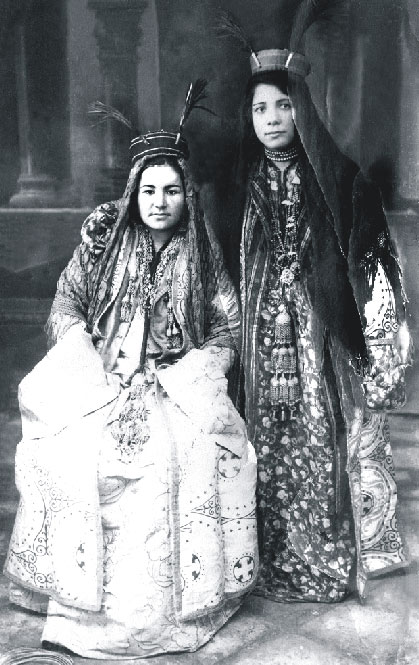
The jevak in three layers worn by the girl in Picture 1 is wrought following the Bukhara school of jewellery-making art. It was a festive and colourful piece of jewellery. It was made either short or very long, with multiple layers. The stringing consisted of corals, lal, beryls, pearls and interim elements stamped as barley grains or other shapes, as well as medallions in the form of blooming lotus flowers.
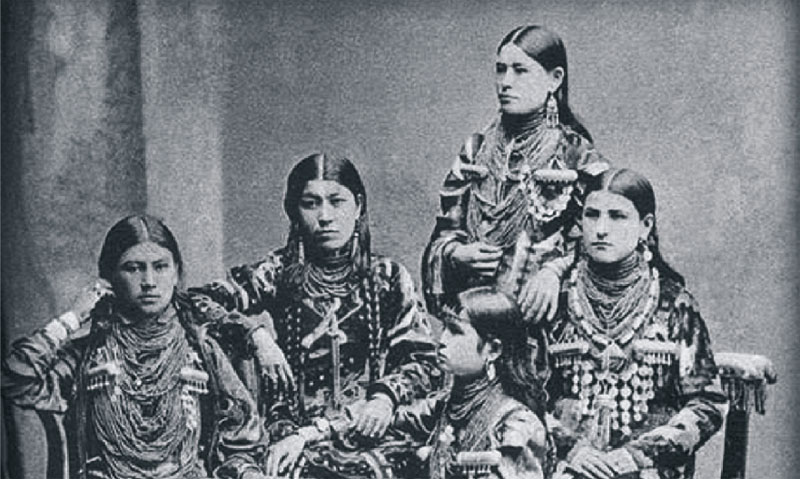
The most senior of the five concubines in Picture 2 wears the smallest number of coral threads: four by three layers. The others have several dozens of them, covering their necks from chin to collarbones and chest, reaching their waistline. Reasons could be any but aesthetic. It was believed the “against barrenness women wear necklaces of amber and small coins, as well as corals and cloves; to preserve their beauty and good complexion they put on only amber necklaces, and to keep a husband faithful a necklace of coral alone is worn”. Besides, the four girls wear kush-tumor and tanga-jevak jewellery made following a method developed in Surkhandarya school of jeweller’s art. Kush-tumor pieces were mostly manufactured by masters from Tashkent and Samarqand. Every concubine has differently styled rings and earrings: the youngest of them has kashgar-baldok earring of Fergana jewellery school, while the other wears oyna-zirak of the Tashkent school; perhaps this is an indication that the concubines came from different regions of Central Asia.
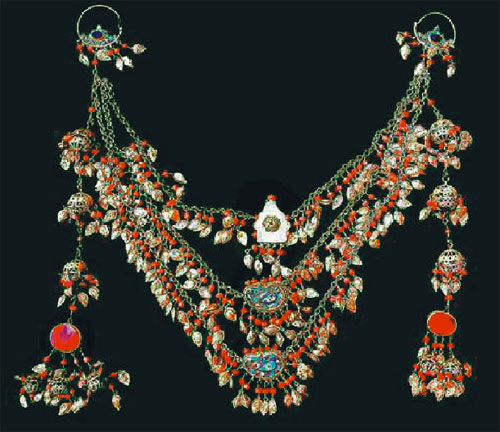
The basis for positioning pieces of jewellery came from an established custom of protecting woman’s body from evil powers. Coral necklaces were worn by women not only in Khorezm, but also in Tashkent. The number of gems depended on the woman’s economic situation. Apart from that, jewellery was apparently meant to highlight ethnic background of its owner.
D. A. Fakhretdinova noted that “In the past, jewellery items performed socio-economic function, serving as visual indicator of a person’s hierarchical and material situation in society. Not less important was their aesthetic function: the expression of people’s tastes, their worldviews and understanding of harmony and beauty, which delight a human being”.
Literature
1. Иванин М. Н. Хива и река Амударья. СПб., 1873.
2. Иванов П.П. Архив Хивинских ханов XIX в. М., 1940.
3. Фахретдинова Д. А. Ювелирное искусство Узбекистана. Ташкент, 1988.
4. Хидия. Комментарии мусульманского права/Пер. Н. И. Гродекова. Т. IV, Ташкент, 1893.
5. Хорошихин А. П. Сборник статей, касающихся до Туркестанского края. СПб., 1876.
6. Россикова А. Е. По Аму-Дарье от Петро-Александровска до Нукуса // Русский вестник. Т. 280. СПб., 1902.
Oydin Kambarova